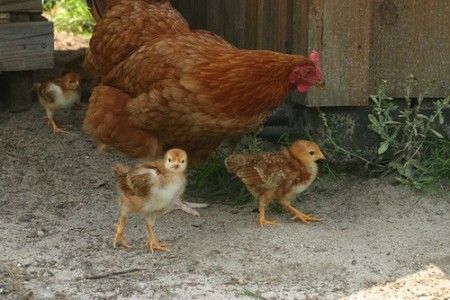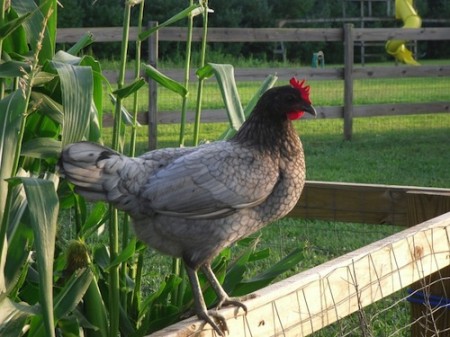- A well-briefed Olivier De Schutter, UN Special Rapporteur on the Right to Food, reflects on biodiversity for food and agriculture as a public good. Video. Comments closed!
- UK genebanks are wonderful, says chair of British Society of Plant Breeders.
- Getting ready for a possible ban on pig castration, the Nordic Food Lab tells us how to deal with Boar Taint.
- The things you can learn from strawberries (if you can hold off eating them).
- More money for research on organic agriculture shock plea.
- HRH Prince Charles didn’t use the R-word, but you know he might just possibly agree.
- I wonder whether he realises that the evolution of resistance by insect pests is predictable.
- If cassava is such a Rambo root, how come it quivers before a fly? Even a super-fly?
- And if that isn’t enough to keep you busy over the weekend, how about celebrating World Gin Day tomorrow, with a good book (and a glass) in hand, natch.
The state of chickens
Luigi pointed me to a nice graphic poster of the officially approved bird for all 50 of the United States. Among them, I noticed two chickens, for Delaware and Rhode Island. Rhode Island might seem obvious enough, the Rhode Island Red being almost the canonical farmyard bird.

But Delaware, not so much.
In fact Delaware was one of the biggest poultry and egg producing states in the Union. Sussex County DE, where the modern broiler industry began, still holds the record for egg and poultry sales, “with $707 million, or 1.9 percent of the total U.S. value” in 2007. That’s almost 2% of the value from 0.024% of the land. But Delaware’s state bird – the Blue Hen Chicken – is not one of the squillions (many of them carrying Rhode Island Red genes, I’ll warrant) that contribute to Sussex County’s top cock status. It isn’t even a real breed. ((Photos from backyardchickens and rapideye.))

Nope; apparently Delaware’s blue hen chicken is a reminder of the Revolutionary War. Exactly how remains uncertain. Cock-fighting was common there at the time, and the Delaware Regiment may or may not have carried feisty blue gamecocks into battle, may or may not have been as feisty as a blue gamecock, and may or may not have looked like a flock of feisty blue gamecocks in their natty uniforms. There is a flock of blue hen chickens at the University of Delaware, whose mascot is the blue hen chicken, but it was created in the 1960s by H.S. Hallock du Pont, and has not been recognized as a proper breed, perhaps because it does not, in fact, breed true. Yet.
Nibbles: Tree domestication, Sacred groves, Solomons aquaculture, Bees and diversity
- Cultivate medicinal trees to save them. Oh, and provide medicines.
- Or you could harvest them sustainably from sacred forests?
- Reef fished out? Aquaculture to the rescue. Sounds a bit like the aquatic equivalent of the above, no? But do they have sea cucumbers and their poop in those inland ponds?
- Growing diverse crops good for bees, good for crops. Buckwheat diverse enough for ya?
Nibbles: Indian farmer, Indian farming landscape, Guatemalan protected areas, Old phones, Geo-data, HarvestPlus funding, Cavia, Agronomy, Bee bank, De-extinction
- Bhogpur farmer Subash Chander Misra gets Plant Genome Savior Farmer award 2012 for pear conservation.
- While a whole farming system gets protected in Kerala.
- Hope it doesn’t go the way of protected areas in Guatemala. Maybe they need old mobile phones. Or a better roads or urban expansion dataset. Or maybe just their own maps.
- UK government puts money where mouth is with grant to HarvestPlus. For things like this from ICRISAT. And have you seen the BBC slideshow?
- Funnily enough, nobody talking about guinea pigs as a solution for malnutrition.
- How Australian agriculture improved its water use efficiency. Clue: it’s not one thing. Good to be reminded, yet again, that’s it’s not necessarily always and only about the diversity. Keeps us centred.
- Bees get a bank?
- The de-extinction debate rumbles on. Centred, did someone say?
Nibbles: Pretty, Peak soil, Wine history, Ancient foodways, Offal, Durian, Exotic plant foods, Cassava, Mozzarella, Nutrition report, Superfoods
- Jules Pretty meditates on the impermanence of things.
- Like soil. And bumblebees.
- Ah, well, let’s not get maudlin. Pass the bottle. Well looky here. The French got wine from the Italians. I feel better already.
- And Canadians had clam gardens a thousand years ago. Probably still do, actually.
- Along with offal, no doubt. Which did not, however, seem to play any role in a recent Mesolithic dinner. Though French wine did. Which is weird.
- The best fruit in the world gets the Kew treatment.
- And is included in a weird list of the 100 weirdest food plants.
- Cassava‘s pretty weird too.
- The best cheese in the world is not French either.
- All of which foods no doubt feature in FAO’s new report on nutrition. Which is really important, so don’t let the flippancy fool ya. The Lancet agrees. And you can do your bit too.
- Ah, but does quinoa feature in that FAO report? The backlash continues…